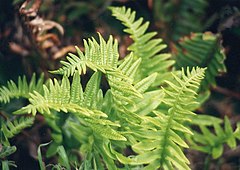Polypodiales: Difference between revisions
add reference for divergence subsequent to angiosperms |
remove family |
||
| (8 intermediate revisions by the same user not shown) | |||
| Line 11: | Line 11: | ||
| subdivision_ranks = Families |
| subdivision_ranks = Families |
||
| subdivision = |
| subdivision = |
||
* [[Aspleniaceae]] |
|||
* [[Blechnaceae]] |
|||
* [[Davalliaceae]] |
* [[Davalliaceae]] |
||
* [[Dennstaedtiaceae]] |
|||
* [[Dryopteridaceae]] |
* [[Dryopteridaceae]] |
||
* [[ |
* [[Elaphoglossaceae]] |
||
* [[Hypodematiaceae]] |
|||
* [[Lomariopsidaceae]] |
* [[Lomariopsidaceae]] |
||
* [[Oleandraceae]] |
* [[Oleandraceae]] |
||
* [[Onocleaceae]] |
|||
* [[Polypodiaceae]] |
* [[Polypodiaceae]] |
||
* [[Pteridaceae]] |
|||
* [[Saccolomataceae]] |
|||
* [[Tectariaceae]] |
* [[Tectariaceae]] |
||
* [[Thelypteridaceae]] |
|||
* [[Woodsiaceae]] |
|||
}} |
}} |
||
| Line 33: | Line 26: | ||
The 15 families of Polypodiales are listed here from those considered most [[basal (phylogenetics)|basal]] to those considered most [[derived]]<ref>Smith, A. R., K. M. Pryer, et al. (2006). "A classification for extant ferns." Taxon 55(3): 705-731</ref>: |
The 15 families of Polypodiales are listed here from those considered most [[basal (phylogenetics)|basal]] to those considered most [[derived]]<ref>Smith, A. R., K. M. Pryer, et al. (2006). "A classification for extant ferns." Taxon 55(3): 705-731</ref>: |
||
* [[Lindsaeaceae]] |
|||
===''Polypodium'' clade=== |
|||
* [[Saccolomataceae]] |
|||
* [[Dennstaedtiaceae]] |
|||
* [[Pteridaceae]] |
|||
* [[Aspleniaceae]] |
|||
* [[Thelypteridaceae]] |
|||
* [[Woodsiaceae]] |
|||
* [[Blechnaceae]] |
|||
* [[Onocleaceae]] |
|||
* [[Dryopteridaceae]] |
* [[Dryopteridaceae]] |
||
* [[Elaphoglossaceae]] |
|||
* [[Hypodematiaceae]] |
|||
* [[Lomariopsidaceae]] |
* [[Lomariopsidaceae]] |
||
* [[Tectariaceae]] |
* [[Tectariaceae]] |
||
| Line 57: | Line 45: | ||
* Platyceriaceae - now in Polypodiaceae |
* Platyceriaceae - now in Polypodiaceae |
||
* Pleursoriopsidaceae - now in Polypodiaceae |
* Pleursoriopsidaceae - now in Polypodiaceae |
||
* Vittariaceae - now in Pteridaceae |
|||
== References == |
== References == |
||
* [http://homepages.caverock.net.nz/~bj/fern/list.htm Checklist of Ferns and Fern Allies] |
* [http://homepages.caverock.net.nz/~bj/fern/list.htm Checklist of Ferns and Fern Allies] |
||
<references/> |
<references/> |
||
* http://dukespace.lib.duke.edu/dspace/bitstream/10161/181/1/D_Schuettpelz_Eric_a_052007.pdf |
|||
[[Category:Polypodiales|*]] |
[[Category:Polypodiales|*]] |
||
Revision as of 00:34, 13 January 2010
| Polypodiales | |
|---|---|

| |
| Polypodium californicum | |
| Scientific classification | |
| Kingdom: | |
| Division: | |
| Class: | |
| Order: | Polypodiales
|
| Families | |
The order Polypodiales encompasses the major lineages of polypod ferns, which comprise more than 80% of today's fern species. They are found in many parts of the world including tropical, semitropical and temperate areas. The characteristics of this group include: sporangia with a vertical annulus interrupted by the stalk and stomium; indusia laterally or centrally attached (or lost); gametophytes green, chordate, and surficial[1].
Polypodiales may be regarded as one of the most evolutionarily advanced orders of monilophytes (ferns), based on recent genetic analysis. They arose and diversified about 100 million years ago, probably subsequent to the diversification of the angiosperms.[2]
The 15 families of Polypodiales are listed here from those considered most basal to those considered most derived[3]:
Polypodium clade
- Dryopteridaceae
- Elaphoglossaceae
- Hypodematiaceae
- Lomariopsidaceae
- Tectariaceae
- Oleandraceae (formerly Olandraceae)
- Davalliaceae
- Polypodiaceae
Now-obsolete families of Polypodiales:
- Drynariaceae - now in Polypodiaceae
- Grammitidaceae - now in Polypodiaceae
- Gymnogrammitidaceae - now in Polypodiaceae
- Loxogrammaceae - now in Polypodiaceae
- Nephrolepidaceae - now in Lomariopsidaceae
- Platyceriaceae - now in Polypodiaceae
- Pleursoriopsidaceae - now in Polypodiaceae
- Vittariaceae - now in Pteridaceae
References
- ^ Smith, A. R., K. M. Pryer, et al. (2006). "A classification for extant ferns." Taxon 55(3): 705-731
- ^ "Ferns diversified in the shadow of angiosperms", Nature, 428 (6982): 553–557, 2004, doi:10.1038/nature02361, PMID 15058303
- ^ Smith, A. R., K. M. Pryer, et al. (2006). "A classification for extant ferns." Taxon 55(3): 705-731
